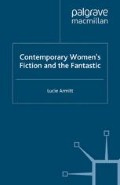Abstract
There is an obvious paradox inherent in writing on the “contemporary” on the threshold of a new millennium, particularly when the original publication dates of the 23 novels upon which the study is primarily based span the last 35 years of the “old” millennium. That we recognize the existence of the paradox also reminds us that the contemporary is not a synchronic “pausing for breath” which implies that a novel written in 1967 somehow shares the same politics or poetics as one written in 1996. Particularly in relation to feminism, the three decades in question have been both revolutionary and disappointing: so much has been achieved, and yet so much remains uncharted, or even lost.
Access this chapter
Tax calculation will be finalised at checkout
Purchases are for personal use only
Preview
Unable to display preview. Download preview PDF.
Notes
Louis Marin, “The Frontiers of Utopia”, in Krishan Kumar and Stephen Bann (eds), Utopias and the Millennium (London: Reaktion Books, 1993), 10.
Virginia Woolf, A Room of One’s Own (London: Grafton, 1977), 7–8, 95, 47, 107–8.
Gaston Bachelard, The Poetics of Space, trans. Maria Jolas (Boston: Beacon Press, 1994), 53.
Mark S. Madoff, “Inside, Outside and the Gothic Locked-Room Mystery”, in Kenneth W. Graham (ed.), Gothic Fictions: Prohibition/Transgression (New York: AMS Press, 1989), 49.
Adalaide Morris, “First Persons Plural in Contemporary Feminist Fiction”, Tulsa Studies in Women’s Literature 11 (1992), 12.
Lynne Pearce, Feminism and the Politics of Reading (London: Arnold, 1997).
Terry Castle, The Apparitional Lesbian: Female Homosexuality and Modern Culture (New York: Columbia University Press, 1993), 2 and 30–1.
Daphne du Maurier, Rebecca (London: Arrow Books, 1992). Subsequent quotations are referenced within the main body of the text, accompanied by the abbreviation R.
Sandra Gilbert and Susan Gubar, The Madwoman in the Attic: The Woman Writer and the Nineteeth-Century Literary Imagination (New Haven, CT: Yale University Press, 1984), 38.
Donna J. Haraway, Simians, Cyborgs and Women: The Reinvention of Nature (London: Free Association Books, 1991), 149 and 180.
Cyndy Hendershot, “Vampire and Replicant: The One-Sex Body in a Two-Sex World”, Science Fiction Studies 22 (1995), 373–98.
Donna J. Haraway, Modest Witness@Second_Millennium.FemaleMan©_Meets_ OncoMouseTM: Feminism and TechnoScience (New York: Routledge, 1997), 74.
Jenijoy La Belle, Herself Beheld: The Literature of the Looking Glass (Ithaca, NY: Cornell University Press, 1988), 104.
Anne K. Mellor, Mary Shelley: Her Life, Her Fiction, Her Monsters (New York: Routledge, 1989), 128.
Morris, “First Persons Plural in Contemporary Feminist Fiction”, 25. Rosemary Jackson, Fantasy: The Literature of Subversion (London: Methuen, 1981), 87–8.
Mary Daly, Gyn/Ecology: The Metaethics of Radical Feminism (London: The Women’s Press, 1979), 3.
Claire Kahane, Passions of the Voice: Hysteria, Narrative, and the Figure or the Speaking Woman, 1850–1915 (Baltimore: Johns Hopkins University Press, 1995), 17.
Sigmund Freud, Case Histories I, Penguin Freud Library, Vol. 8, ed. Angela Richards (Harmondsworth: Penguin, 1990), 29–164.
E.T.A. Hoffmann, “The Sandman”, in Tales of Hoffmann, trans. R.J. Hollingdale (Harmondsworth: Penguin, 1982), 85–125.
Lynne Pearce, Reading Dialogics (London: Edward Arnold, 1994).
Lucie Armitt, Theorising the Fantastic (London: Arnold, 1996), 183–6.
Joanna Russ, The Female Man (London: The Women’s Press, 1985), 213–14.
Tzvetan Todorov, The Fantastic: A Structural Approach to a Literary Genre, trans. Richard Howard (Ithaca, NY: Cornell University Press, 1975), 24–5.
Leslie Fiedler, Freaks: Myths and Images of the Secret Self (New York: Simon and Schuster, 1978), 91.
Author information
Authors and Affiliations
Copyright information
© 2000 Lucie Armitt
About this chapter
Cite this chapter
Armitt, L. (2000). Introduction. In: Contemporary Women’s Fiction and the Fantastic. Palgrave Macmillan, London. https://doi.org/10.1057/9780230598997_1
Download citation
DOI: https://doi.org/10.1057/9780230598997_1
Publisher Name: Palgrave Macmillan, London
Print ISBN: 978-0-333-69453-4
Online ISBN: 978-0-230-59899-7
eBook Packages: Palgrave Literature & Performing Arts CollectionLiterature, Cultural and Media Studies (R0)

